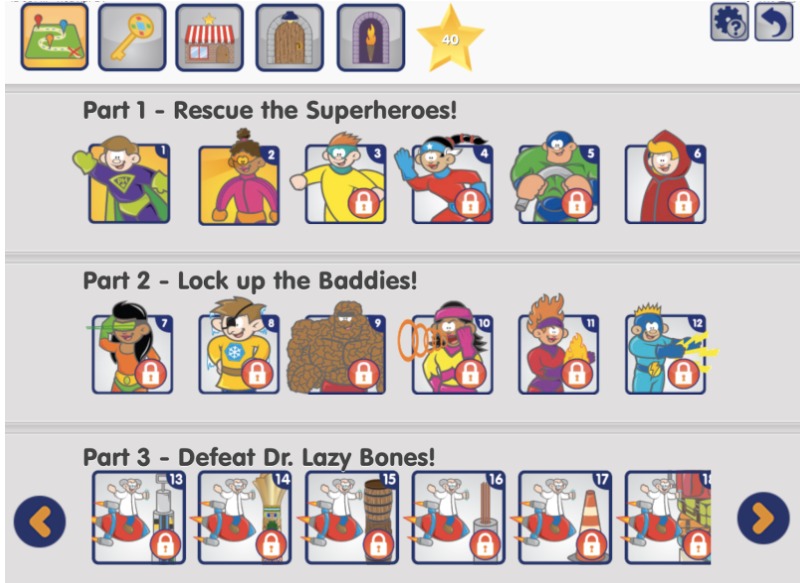Literacy experts at Phonics.org explore different phonics and reading programs for kids. By sharing honest reviews, we hope you can make more informed choices about the educational tools you use with your beginner readers!
In this article, we share our Phonics Hero review and discuss the pros and cons of its approach to literacy instruction. Let’s dive in!
About the Phonics Hero App
Phonics Hero is an engaging literacy program designed for children ages 4 to 7. It offers instructional exercises for:
- Letter sounds
- Word reading
- Sentence reading
- Spelling skills
- Vocabulary
Phonics Hero also provides valuable resources for parents and teachers. Examples include printable worksheets and a classroom dashboard for educators to track students’ progress and assign specific activities.
Read on to learn more about the quality of different components in the Phonics Hero program.
Getting Started With Phonics Hero
How does it work? Is it effective for kids? Let’s look at the usability and user interface of the Phonics Hero program.
Signing Up
The sign-up process is straightforward and easy for parents and teachers. Teachers have the option to select the preferred accent used in the app: English, American, or Australian. As learning to read and spell is sound-based, it is important to have the option to train students in their home dialect.
Logging In
The log-in process is also straightforward for a single child at home. However, the app presents log-in challenges in a classroom setting. Each child receives a unique username and password, unlike other apps that offer simpler methods like choosing a nickname or using picture passwords. This can be tricky for younger children in a classroom as they may require significant practice and support to log into the app independently.
Using Placement Tests and Teacher Choices
Teachers can choose whether new students complete a placement test that assigns them to a place in the learning sequence. Alternatively, they can select where the student should start. This level of customization empowers educators to scaffold learning and see that each student is appropriately challenged in their learning journey.
The teacher dashboard is exceptionally user-friendly. Teachers can easily manage student learning goals and access comprehensive feedback on student performance. Additionally, printable materials that align with the lessons are accessible to add extra practice.
Playing Phonics Hero Games
Gameplay determines engagement, which is important for learning. These factors contribute to the engagement aspect of the Phonics Hero platform.
Games and Activities
Phonics Hero games are not only entertaining but also varied. The navigation features make it easy for young players to explore and interact with the app independently.
Instructions for games are clear and can be repeated as many times as the player needs. This is a helpful feature for kids who may have difficulties with hearing, attention, or memory.
Phonics Hero also features an engaging, overarching story with interesting superhero characters and various missions for children to accomplish. This is a fun, interactive addition to the games.

Rewards
Children earn stars by completing academic tasks, which can then be used to purchase items in a store within the app. These items—represented as digital stickers—can be placed in a secret hideout. The reward system adds an extra layer of engagement and is implemented in a way that’s unlikely to significantly detract too much from learning time.

Loading Times
Each log-in, navigation, and transition to a new game creates additional loading times in the game where a child needs to wait. The wait times vary, but can disrupt the flow of learning and engagement.
Learning with Phonics Hero
Here are the main factors that contribute to the overall quality of literacy instruction in Phonics Hero.
Lesson Organization
The lesson organization in Phonics Hero follows a clear and logical scope and sequence that accommodates various accents and regions. This structure is well-communicated on the Phonics Hero website.
Each level presents a sequence of lessons that systematically progress through key literacy skills:
- Know
- Read
- Spell
- Camera Read
- Camera Spell
- Sentence Reading
Camera reading and spelling refers to commonly used irregular words in the English language such as the word ‘of.’ Within each lesson, multiple opportunities and games are provided to practice and reinforce each step of the learning process. This systematic approach ensures kids are learning key literacy skills with a logical and clear step-by-step method.
Letter Sounds
The Phonics Hero program teaches letter sounds clearly and accurately. Phonics Hero provides ample practice opportunities for mastering these sound-letter correspondences, contributing to effective skill reinforcement. Phonics Hero does not include letter formation (printing) as part of the lessons.

Letter Names
The app makes the interesting choice of excluding letter names in its instruction. As deliberately explained in this blog post, “Unfortunately, many children are introduced to letter identification by well-meaning parents and grandparents even before school entry. Teaching letter names before sounds is far from helpful.”
If you’re a parent or grandparent reading this, don’t worry. Experts have found that learning letter names before sounds is not detrimental for your children. In fact, knowing letter names is very helpful when learning to read and spell. Phonics Hero would be a stronger reading program if it included letter names as well as letter sounds in the early lessons.
Type of Phonics
Phonics Hero employs a synthetic phonics approach, which is supported by research and considered the most logical method for teaching reading and spelling. This approach involves breaking down words into individual sounds or blending individual letter sounds to form words. Synthetic phonics is highly effective for developing word-reading skills.
Phonemic Awareness
Phonics Hero includes phonemic awareness practice in their program. Blending and segmenting skills are prioritized in the game. These are important skills for new readers to practice and know.
However, 3 meta-analyses of studies on this topic have shown that practicing these skills with letters doubles the effectiveness of the activity. Unfortunately, Phonics Hero focuses on mostly using these skills without letters. The Phonics Hero website suggests waiting until a child consistently segments and blends orally before introducing letters or letter-sound correspondences. In reality, this skill can be introduced concurrently (with letters).
Finally, Phonics Hero uses final blending as the only type of phoneme blending in the program. However, it’s typically easier for children to start blending with continuous blending. This strategy may need to be supplemented to get a student started before using the program.
Type of Texts
Phonics Hero uses decodable texts. These are texts where the sounds and words being taught and practiced are integrated into the reading material. Decodable books discourage “guesswork” and encourage accurate decoding skills. These texts also include phrases and sentences, providing a supportive scaffold for transitioning from word-reading to sentence reading.
Spelling
Phonics Hero implements effective spelling procedures, including some direct instruction on segmenting words into sounds with letters, which is beneficial. The use of chaining, where one letter is changed at a time to form a new word, is also an effective strategy for spelling instruction.

Phonics Hero uses boxes in the general shape of the letter to reinforce spelling. This is not a useful method of spelling instruction. The focus in early spelling instruction should be on the sounds in the word. Identifying the outer shape of the word does not help with learning to spell.

There are also small errors in the “camera spelling” section. This spelling practice is mostly for irregular words that don’t entirely match the regular phonics patterns in English.
When a child makes an error in this spelling section the program provides the sounds for the word. Unfortunately, the sounds provided in the program don’t match the word. For example, the word ‘his’ has the sounds /h/, /i/ /s/; when the final sound in ‘his’ is a /z/ sound. Making these differences and exceptions clear to children helps them identify the irregular part of the word and they will be better able to read and spell the word accurately next time.
Quality of the Phonics Hero Platform
Phonics Hero has some useful and effective teaching methods that likely help children reinforce some foundational word-reading concepts. Synthetic phonics is used with a clear, systematic scope and sequence. Phonics Hero incorporates phonemic awareness practice in their program and uses decodable texts at the phrase and sentence level to support kids in building reading fluency. The characters are fun and engaging and the app is generally easy to use.
If I were a teacher or parent using this app with my child, I’d want to know that there are some important aspects of literacy instruction that are missing from the program:
- Phonics Hero does not incorporate letter formation (printing) or letter names. Make sure to include this instruction on your own, as it is important knowledge for children to have.
- The phonemic awareness practice in the app is rarely done with the letters (graphemes). Showing a child how to sound out a word from left to right with letters is going to be crucial practice in addition to the Phonics Hero program.
- The blending skills modeled in this game are limited, so teaching continuous blending before a child gets started would be very helpful.
Overall, many features in the Phonics Hero serve as valuable resources for literacy instruction. The app can be effectively used with some key additions and guidance from a literate adult.
To consider other phonics programs, read more on the Phonics.org reviews page!
Phonics Hero Rating
Quality of Literacy Instruction: 3.5 / 5
Usability: 3.5 / 5
Engagement: 4 / 5

